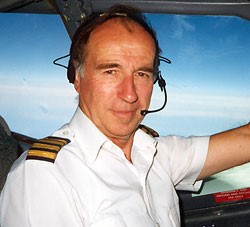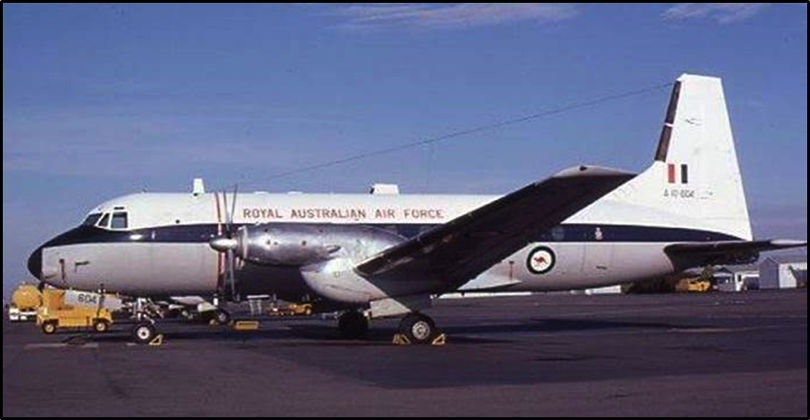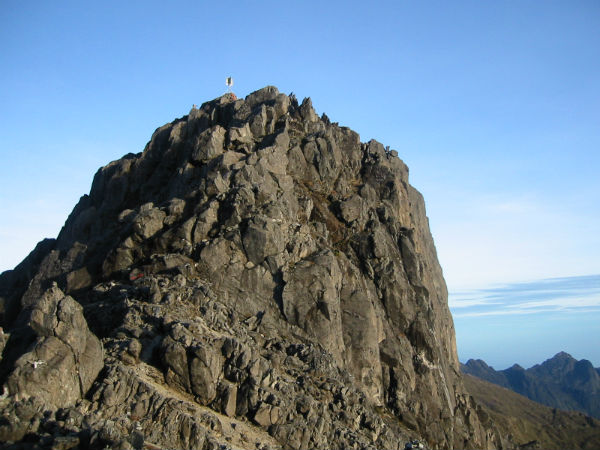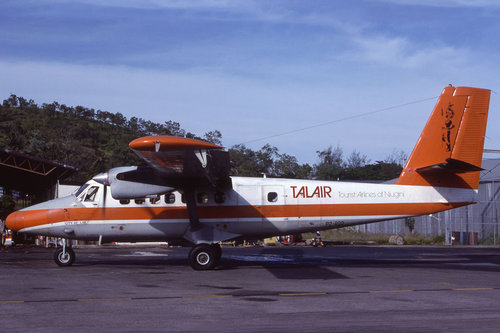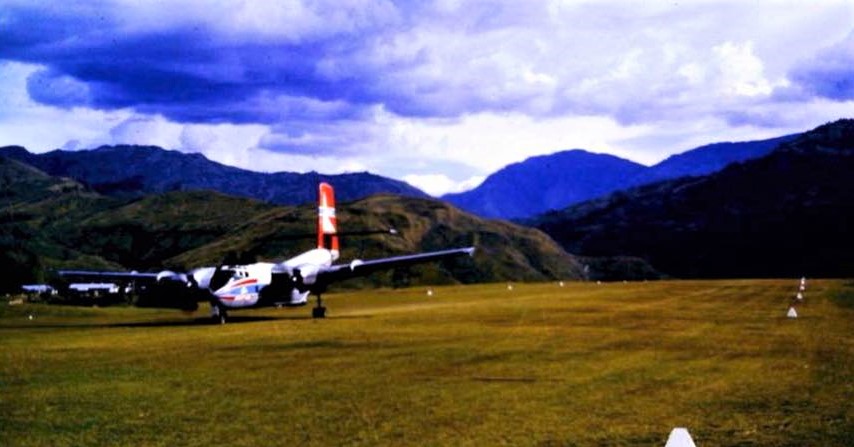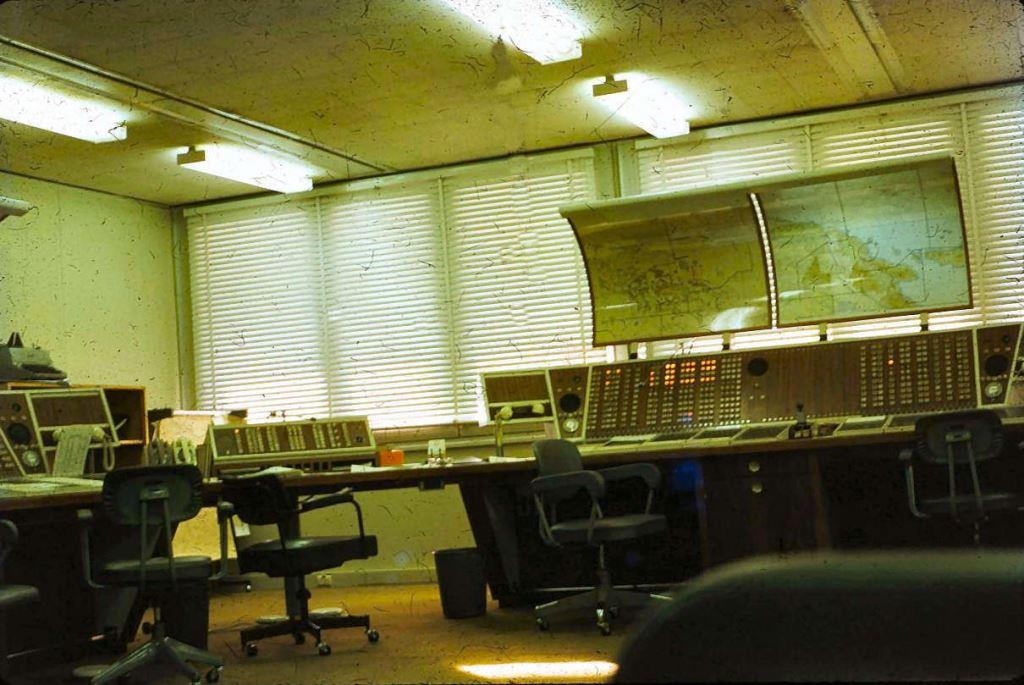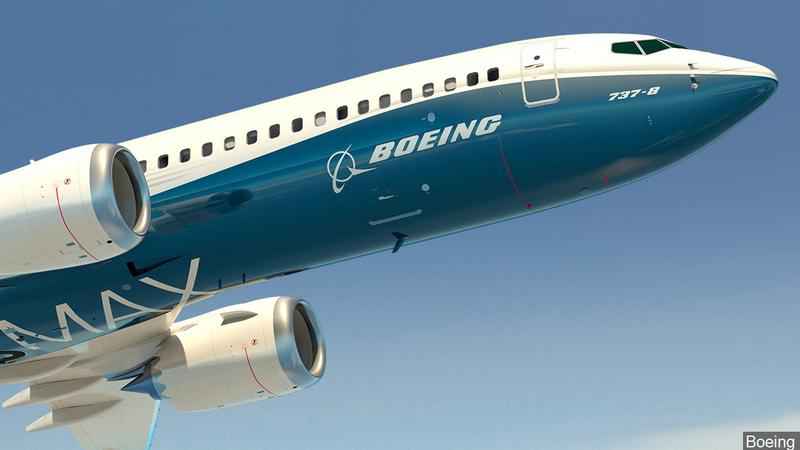|
|
||
|
||
|
Privacy Policy | Editorial Policy | Profit Policy | Join the Association | List of Members | Contact us | Index | Links |
||
|
Back Go to page: 1 2 3 4 5 6 7 8 9 10 11 12 13 14 15 16 17 18 19 20 Forward
|
||
|
John Laming Aircraft and other stuff. |
||
|
Contents:
|
||
|
|
||
|
Scud Running in the mountains of Papua New Guinea
This story starts at the picturesque port of Madang on the northern coast of New Guinea. It was August 1969 and I was flying an RAAF Hawker Siddeley HS748 on a two week tour around New Britain and New Ireland, culminating with the training of a new squadron pilot in the finer points of Highland operations in central Papua.
We had earlier flown into places of wartime history such as Rabaul, Kavieng, Manus Island (remote Momote), Finschhafen, Lae, and Wewak. Now we were to operate deep into mountain country, navigating through the various gaps in the ranges around Mount Hagen and Goroka. After a night of merrymaking at Madang, we had planned to depart after lunch and visit Mount Hagen, Minj and Banz which were situated along the Waghi Valley, itself surrounded by mountain ranges up to 14,000 feet above sea level.
The base of the Waghi was over 5000 feet above sea level, which in turn meant very high density altitudes in terms of takeoff and landing performance. The airstrip lengths were just adequate for our planned take off weights and back at Canberra, our home base, we had practiced flying from a 2300-foot grass strip situated alongside the main long north-south runway.
Airborne out of Madang, we climbed to 15,000 feet, backtracking on the Madang NDB for Minj, some 100 miles over rugged country to the south west. As we passed over the winding rivers of the Ramu Valley, heavy cloud could be seen covering the mountain gaps adjacent to the 14,800-foot summit of Mount Wilhelm. New Guinea weather is characterized by massive cloud build up over the mountain ranges by early afternoon. We were aware of this problem, and, in fact, it suited us nicely, as the purpose of the trip was navigation in mountain areas.
The HS748 had a good altitude capability, and I knew that providing we stayed VMC we could climb out of trouble if we got caught in bad weather. With five minutes to ETA at Minj, our first landing spot, there were three of us up front, all map reading. Standing between the two pilots, the navigator was the first to spot a cloud break, which placed us over the eastern end of the Wahgi valley only a few miles from Minj. Radio reports from other aircraft indicated that heavy rain showers were causing bad visibility around Mount Hagen to the northwest and Goroka to the southeast.
One report gave lowering visibility in the Waghi Valley. We dropped the landing gear, and lost height in a series of turns designed to keep us clear of stratus and towering cumulus. I had a feeling of uneasiness at the sight of areas of nimbus rain cloud drifting across the base of the mountains leading down to the valley. We had momentarily lost radio contact with Madang Flight service after advising that we were in the vicinity of Minj, and that we would cancel SAR watch on the ground. The cloud around Minj was low and black, and we were forced to circle at 1000 feet above the valley on area QNH in order to get a pinpoint. Neither Minj, nor nearby Banz, was visible in the rain.
Once under the main cloud base, we could see that both ends of the Wahgi Valley were blocked with heavy veils of dark rain cloud, and I felt that the time had arrived to get back to Madang, fast. The cloud break through which we had descended had by now filled over, and with the proximity of mountains it would have been suicidal to climb in IMC. We were relieved, however, to spot a Twin Otter (right) emerging from the rain and obviously heading down the valley for Goroka some 30 miles to the southeast.
You’re a better man than I am, Gunga Dhin, I thought, and with gear retracting I turned to follow him to safety. He did not reply to our radio calls, so I swung in behind him and trailed line astern by a few hundred yards. I doubt if he was aware of our presence.
As we flew past the tiny airstrip of Kundiawa (Chimbu) situated upon a ridge overlooking the rapids of the Chimbu River, I made a mental note that, as a last resort, I would plant the HS748 squarely on the threshold, and work out how to get out of the place once safely ensconced in the pub — if there was one! Meanwhile the Twin Otter had drawn ahead and began to disappear into heavy rain. Our windscreen wipers were now going flat out, and in the cockpit three pairs of eyes were pinned against the windscreen looking for our saviour.
This was getting serious, and as I had no way of knowing if the “Twotter” was about to do a 180 for his own safety, I hauled into a limit turn and back towards the relative safety of clear air near the Chimbu River. A few minutes later, we were orbiting Kundiawa airstrip with the awful realisation that this tiny grass strip, balanced precariously on top of a narrow ridge, was going to be our home for the night. In my mind I could already visualize the waiting military court martial back at Canberra. Ansett Caribou at Chimbu airstrip
A be-medalled Wing Commander would coldly ask why I had pressed on regardless into the Wahgi Valley in worsening meteorological conditions, and despite other aircraft reporting bad weather closing in. Would it not have been considered good airmanship to return to Madang while still on top of clouds? I could have replied quite truthfully that it seemed a good idea at the time and also that the last time I stayed at Minj, we had enjoyed a fine party with some expatriate wives whose patrol officer spouses were away in the hills chasing murderers.
However, to admit that, would have been to dig my own grave, not only with the court martial, but with vengeful husbands.
By now, I had run out of ideas, and like it or not, I had to get the 748 on the ground before approaching rain clouds cut visibility to zero. I have seldom felt so alone and although the term CRM or crew resource management had yet to be coined, I asked the rest of the crew if they had any suggestions. The navigator thought it might be worth flying along the Chimbu River valley a few miles north, to see if the Bundi Gap into the Ramu River plains was open. Mountains disappeared into cloud on both sides of the Chimbu valley, leaving very little room to turn tightly if the gap was closed and we had to get back to Kundiawa. It was a gamble that I decided not to take, mainly because of the danger of the weather socking in at Kundiawa while we were poking our noses further up the valley towards the Bundi Gap. In any case, I was not confident of my ability to recognize the Gap if I saw it.
With a deep breath, I announced we were committed to land at Kundiawa. We had lost communications with Madang, and could only hope we could find a telephone on the ground in time to prevent a full scale search operation. After an inspection run over the strip, I set the aircraft up for a precautionary landing approach and turned on to final. As we straightened up, the three of us simultaneously spotted rays of sunlight slanting against the eastern slopes of jungle covered rising ground a mile or so up the gorge of the Chimbu River. Where there is sunlight, there must be a hole in the clouds, which might offer a chance of climbing away in the clear.
I pushed open the throttles, retracted the gear and flaps, and keeping to one side of the gorge to allow for a tight 180, we checked out the sunbeams. To our collective relief, the parting of the clouds showed there was just enough to circle within, although we would lose out badly in rate of climb if we were forced into a series of steep climbing turns. There was also the possibility of the cloud closing up and trapping us in IMC as we circled upwards. I decided the best course of action would be to zoom climb at full takeoff power until being forced to lower the nose, then resume a spiral climb to keep within the edges of the cloud until reaching safety on top. With this plan in mind, I turned back towards Kundiawa to give room to manoeuvre and switched on the water methanol pumps to give the engines full boosted power.
Having got into position, I went to full takeoff power, felt the water methanol cut in with a jolt, and dived at maximum permitted speed, plus some, towards the scattered sunlight on the mountain side. As the sun glinted on the wings, I looked up through the cockpit side window at patches of blue sky several thousand feet above and decided instantly that it was a goer. Hauling back, I pulled up as steeply as I dared, while keeping a close eye on the rapidly unwinding airspeed indicator. As the speed died away and the VSI fell back, I noticed that the water methanol contents showed nearly empty, which meant that when the methanol cut out, the Rolls Royce Dart engines would lose considerable power. I hoped there would be enough remaining in the water methanol tanks to get us on top of the cloud and thus safely back to Madang.
Well, we managed to climb safely through that beautiful hole in the clouds, and also back in radio contact with Madang. Flight Service was not overly concerned at our loss of communication as this was a routine event in the Highlands. An hour later we were back at the bar of the Smuggler’s Inn at Madang, downing the first of many cold beers. In hindsight, I should have turned back to Madang when aircraft reports indicated bad weather at both ends of the Wahgi Valley.
But it seemed a good idea at the time.
Click HERE to see a RAAF Caribou flying into and out of Bundi, a small settlement just to the west of Madang and about 2/3 of the way from Madang to Chimbu.
|
||
|
The three ages of man: Youth, age and You're looking wonderful. |
||
|
|
||
|
Whenever there is an event that captures the attention of the public you can bet the Press will trot out the “experts” who, without knowing any of the facts will KNOW for certain the cause of the event and will grab their 15 mins of fame by telling one and all the how and the why the event happened.
A classic example of this followed the dreadful loss of two Boeing 737 Max 8s resulting in the death of several hundreds of people. The Press had a ball, demanding all Max 8s be grounded immediately as they were obviously an un-airworthy aircraft. Two un-identified (of course) pilots in the US have complained about the way the aircraft performed in flight, one saying at one stage the autopilot initiated a brief nose-down situation, he then went to say that’s where the front of the aircraft pointed down just so we all know what a nose down situation is. |
||
|
|
||
|
Someone who flies these things and who doesn’t get all mixed up in the hysteria says:
“What rubbish! I have been hearing all day long from people all over about the bad 737. The Max is a good airplane, eventually the facts will come out that the crashes were caused by crew error. The Lion Air flight because the aircrew did not follow the memory items for runaway stab trim. Even though Boeing screwed up by not properly informing customers of the new anti-stall system, the memory procedure is the same.
Until the Max airplanes, 737s only had two methods by which the stab trim was adjusted absence of pilot input:
The autopilot will trim and if necessary, extend leading edge flaps to full extend, even if in a flaps 5 or less configuration (leading edge devices remain in normal extend until greater than flaps 5). The Max has an added system to allow stab trimming in any configuration to prevent a stall. Boeing caused issues by not properly highlighting the new system to operators. Even at Southwest Airlines (US Carrier) which operates the Max 8, no information or training was given about the new system in recurrent training. EVEN SO, the memory procedure is still the same. The Lion Air crew reportedly re-trimmed the airplane three times manually after the auto trim had run forward to a nose down configuration. It was doing that because the airplane had a reported problem with the pitot systems and the resultant erroneous slow airspeed input to the air data computer caused the airplane to think it was slow and command nose down trim to prevent a stall.
Three times the aircrew over road the nose down trim with the manual trim switch on the yoke and each time the trim began to trim nose down.
I predict that when it is all said and done, the verdict will be pilot error resulting from a poorly trained, low time Indonesian aircrew. The Air Ethiopia crash will be investigated. It sounds like an engine failure and an improper crew response to fly the airplane single engine. They flew it into VMC (into cloud), rolled over and flew straight in.
Here's another goody: the co-pilot on this flight was a 200 hour total time pilot. This means at best, he was only taking up space and using up good atmosphere. I bet when it all comes out, that the airplane was improperly loaded, improperly flown in a single engine configuration and that the Captain was at best a poorly trained, low time, third world airline pilot.
In the US today, every dumb politician and others are calling for grounding the airplane even though they don't know anything about it. China has a good excuse now, to retaliate for the Hue Wei incident with the US and Canada. Now is an excellent time to buy Boeing stock, for soon it will recover from today's hysterical loss and the world will learn that the 737 is a wonderful airplane, just like most other Boeings.”
|
||
|
A man is as old as he looks, and if he only looks.....he's old. |
||
|
|
||
|
The U.S. Air Force has accepted the first Boeing KC-46A Pegasus tanker, an important milestone for the troubled program, however, the initial batch of aircraft will still have serious problems with their remote vision and refuelling boom systems, meaning that the planes remain years away from reaching their full operational potential. |
||
|
|
||
|
The acceptance and up-coming deliveries are a big deal for the KC-46A program which has been mired in delays and controversy since Boeing won the Air Force’s KC-X competition in 2011. That decision itself followed nearly a decade of earlier, scandal-ridden Air Force attempts to procure a new tanker aircraft. Notably, in 2004, Darleen Druyun, a Boeing executive who had previously been the Air Force’s top procurement official, went to federal prison after receiving a conviction on corruption charges relating to an earlier tanker program.
The Air Force was supposed to have received a fleet of 18 KC-46As, the first tranche in the total initial buy of 52 aircraft, by the end of 2017 and reach an initial operational capability with the type shortly thereafter. Between 2011 and 2017, continuing technical difficulties, which you can read about in more detail here, repeatedly pushed this schedule back. This continued into 2018, leading to an unusually public spat between the two parties over the program’s progress. Boeing’s contract is firm, fixed-price, and that company has already had to pay more than $3 billion of its own money to cover cost overruns.
|
||
|
|
||
|
Boeing had expected the Air Force to finally accept the first KC-46 in December 2018, but this was reportedly delayed by former Secretary of Defence James Mattis’ resignation. Acting Secretary of Defence Patrick Shanahan is a former Boeing executive and has had to excuse himself from any dealings related to the company, further lengthening the process for the Pentagon to formally approve the Air Force’s plans.
But Boeing and the KC-46A are hardly out of the woods. The aircraft the Air Force is getting still have serious problems that neither the service nor Boeing expects to be completely resolved for at least another three to four years. The first of these is related to the refuelling boom at the rear of the aircraft. Aircraft that use this aerial refuelling method must work with the tanker to force the probe at the end of the boom into a receptacle on their own plane. If the receiving aircraft can’t generate enough thrust, it might not be able to successfully establish the link and there is a risk that the connection might fail inadvertently in the middle of refuelling.
The KC-46A’s boom has a so-called “thrust resistance” of 1,400 pounds which is higher than the maximum threshold of certain U.S. military aircraft.
Apparently, the Air Force did not specify the lower thrust resistance in the original contract and has now asked Boeing for a design change to meet this requirement. As such, since this is officially a new stipulation, the service has agreed to give the plane-maker additional funds on top of the fixed deal to pay for the work. This is an important concession on the part of the Air Force, which required Boeing to pay out of pocket for a separate boom-related software fix to prevent the probe from damaging the receiving aircraft. The two parties are still negotiating the exact cost for the revised boom design, but they expect the work to take around two years to complete.
A bigger issue remains with the Pegasus’ long-problematic Remote Vision System, or RVS. In the Air Force’s existing KC-135 and KC-10 tankers, an operator at the rear of the aircraft helps guide the boom into the receiving aircraft. On the KC-46A, (as on the RAAF’s Multi-role tankers) this individual performs their task remotely from the main cabin via an advanced stereoscopic video feed that presents a blend of two-dimensional and three-dimensional imagery from an array of electro-optical and thermal cameras at the back of the plane.
|
||
|
|
||
|
“There is a slight difference between the motion viewed in the RVS versus what is actually occurring in the physical world,” an Air Force official explained, “all of those things can create a depth compression and curvature effect.”
What this means is, depending on shadows, glare, and other factors, the boom operator might not have an accurate understanding of what's going on behind the tanker, leading them to over-compensate and move the boom erratically, putting potentially dangerous strain on the boom itself and risking hitting and damaging the receiving aircraft. Additional studies have warned that certain individuals may simply be predisposed to eye strain, headaches, vertigo, and other vision issues when using the system for a protracted period of time, limiting the pool of people who could take on the boom operator job on KC-46s at all in the future.
|
||
|
|
||
|
As part of the acceptance plan, Boeing has agreed to completely overhaul the RVS, which could entail both hardware and software changes to the aircraft and do so at its own cost. The Air Force expects it to take between three and four years to simply develop the replacement system. There is no timeline for how long it might then take to modify any aircraft the service has taken delivery of up to that point.
There have been other deficiencies that Boeing has been working to resolve, as well, and it is unclear how close these are to getting fixed. This includes the boom striking the receiving aircraft, which is especially problematic for stealth aircraft, such as the F-22 Raptor and F-35 Joint Strike Fighter. Damaging the special radar absorbent skin on these aircraft could have a direct impact on their ability to hide from hostile radars. There is a growing, separate discussion about how well a non-stealthy tanker such as the KC-46 will be able to support stealthy manned and unmanned aircraft during any future high-end conflict, in general.
With these major issues remaining, it’s unclear how useful the aircraft will be to the Air Force in their present state. They will definitely serve a purpose in priming the training pipeline for Pegasus crews and getting personnel accustomed to the new tanker. How valuable this training can be, especially for boom operators, if there are major changes still to come, is certainly debatable, though.
The Pegasus is supposed to undergo initial operational test and evaluation (IOT&E) this year, leading to the Air Force declaring an initial operational capability with the type sometime afterward. It's not clear how well it will be able to meet the ITO&E criteria if the thrust resistance and RVS issues remain unresolved. This could limit the KC-46's operational utility, regardless of whether the Air Force decides to declare it has reached an initial operational capability in the next few years until these problems are conclusively fixed.
The acceptance of the first KC-46 is a significant step forward for the program, but it is clear that the Air Force and Boeing still have a long way to go before the new tankers are truly ready for action.
Click the pic below to see a KC-46A being built.
|
||
|
|
||
|
The main thing that's wrong with the younger generation is that I'm not in it. |
||
|
|
||
|
DC3.
The old DC3 was miles ahead of anything when it was released way back in 1936. It is probably one of the most significant transport aircraft ever produced and although an ungainly old thing on the ground, when set free in its element, it is a thing of beauty.
Click the pic below to see it in the air |
||
|
|
||
|
|

